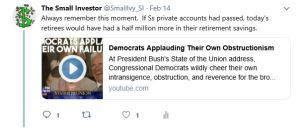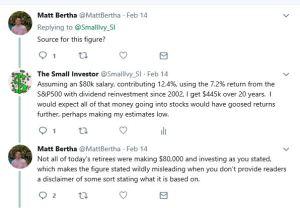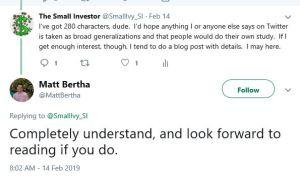A few days ago, Bernie Sanders‘ staff made a Tweet praising Social Security, saying it is the most successful government program in history. In response, I published the video from the State of the Union Address made by George W. Bush
after the Democrats had narrowly defeated privatization of Social Security back in the early 2000’s:
(Note, if you click on a link in this post and buy something from Amazon (even if you buy something different from where the link takes you), The Small Investor will receive a small commission from your purchase. This costs you nothing extra and is the way that we at The Small Investor are repaid for our hard work, bringing you this great content. It is a win-win for both of us since it keeps great advice coming to you (for free) and helps put food on the table for us. If you don’t want to buy something from Amazon or buy a book, how about at least telling your friends and family about our website as a great place to learn about investing and personal finance. Thanks!)
I also made the following tweet:

This resulted in the following exchange:

Which finished with:


Now, to tell the truth, when I said “Always remember this moment. If SS private accounts had passed, today’s retirees would have had a half million more in their retirement savings,” I kind of pulled the $500,000 figure out of the air. I knew it would be a figure around that amount, knowing that, between an employer and an employee, about $5,000-$12,000 per year is going into Social Security for each middle-class worker. This would mean that, even without any returns from the stock market, the account would grow to somewhere between $100,000 and $240,000 over the roughly twenty years that speech had been made. I also figured that most employees who are in their late forties when that speech was given, who would be retiring around now, would be in the prime earning years of their lives, so they would be in the top portion of that range. Add a little return from the stock markets, and I figured that you would get something approaching $500,000.

Shop Amazon Devices – All new Fire HD 8
After being challenged, I went back and checked into the numbers a little better. If I had been grossly in error, I would have corrected the figures. But, looking back at the returns for the S&P500 during that time period and discovering that the returns were about 7.2%, then doing the compound interest calculations for an employee making $80,000 per year, I showed that he’d end up with about $450,000 in the account, which was pretty close to the number I pulled out of the air. Sweet.
Now, I’ll concede that not every employee makes $80,000 per year. But, if you expand that from single employees to couples, you’ll find that many couples will be pulling in something in that range by the time that they are in their late forties even if they didn’t go to college. $80,000 per year is only $40,000 each, or $20 per hour without overtime. It really isn’t a bad guestimate. Many people who are dedicated at work, get training where they can, and work their way up the ladder are at or beyond $20 per hour by their late forties. Many people who work shifts are also getting overtime pay, which can easily push their yearly salaries to $60,000 or more each, so $80,000 isn’t a bad figure to use. Still, I agree that everyone would not be making that much.

Shop Amazon Basics – HDMI Cables
And that’s really an issue when trying to write an analysis of something like privatization of Social Security. It is impossible to do an analysis that takes every situation into account. What about someone who got laid off or injured at 55? What about people who are single earners? What about people who decide to pull their money out of their account early despite the taxes? You simply can’t account for every situation, which is what makes personal finance personal. Then again, you can make some assumptions to get an idea about whether one policy may be better than the other. In this case, the difference between having private Social Security accounts and the current public system is so huge that there is no contest. You could be off by 100% in your prediction on what you’d receive from private accounts and you’d still be 500% ahead.
Also, while it’s difficult to make predictions about things that didn’t happen, you can draw some conclusions just by looking at the scenario logically. If all of the Social Security money were directed into private accounts, which in turn were directed into large index mutual funds, it would have caused the stocks in those funds to go up. This, by itself, would have caused returns to go up, which means that the 7.2% that the S&P 500 did return might have been 10% or 12%. Of course, if a large segment of the population were to retire and draw all of their funds out at once, this might cause stocks to decline in value. Then again, this would not happen if most people left the bulk of their funds invested and drew their accounts down throughout their retirement years, but it could happen if there were no restrictions on withdrawing the funds at retirement. It is difficult to know for sure, however, because we didn’t privatize Social Security. All that we do know is that Social Security continues to pay out about 10 times less per dollar than a 401k invested in a broad set of mutual funds would based on historical returns. We also know that the current Social Security system is running out of money since more people are retiring that starting to work and will need to either cut benefits or raise taxes again soon.

Create Amazon Business Account
So, what would privatize Social Security look like?
Privatized Social Security, properly designed, would look a lot like a 401k plan with the exception that 1) you would not be able to withdraw any of the money until you were of retirement age and 2) the investments made would be fixed. You would not be choosing your investments. Let’s look at the reason for each of these restrictions.
No early withdrawals.
One of the good things about Social Security and private pension plans is that there is no opportunity to withdraw the money early unless you are disabled. A fatal flaw with 401k plans is that you are able to withdraw the money for certain reasons, withdraw the money with a penalty for any reason, and borrow against the balance. Because people generally focus on the near-term needs instead of long term goals like retirement, people will often destroy their future for a reward now. Perhaps if people realized that each dollar now will be worth $120 or more in 40 years, they wouldn’t choose to take money out of their 401k and spend it when they leave an employer, but because they don’t, doing so is very common. A better system wouldn’t let you take out money early, just as you can’t go up to your pension plan manager or the Social Security Administration and get them to give you your money early.
Fixed investments.
People also tend to invest badly. They chase fads. They sell out after a market drop. They invest too aggressively, concentrating their positions too much. The play it too safe, putting all of their money into savings bonds and giving up several percentage points of return. A good private account system would therefore invest the money automatically in a set of diversified mutual funds. Basically, you would buy every significant stock in the US and the shares in many foreign companies as well. Rather than trying to pick stocks, which would result in a corrupt system where connected individuals would bribe and lobby their companies onto the list, every company with a certain net worth would be included. It would be very easy to contract out to a group of mutual fund companies to create and manages such a fund.

Shop Amazon – Best Selling Products – Updated Every Hour
Wouldn’t it be risky to invest Social Security in the stock market?
Whenever private accounts for Social Security are proposed, the risk of investing in the stock market is always cited. It is true that you can lose money in the stock market if you 1) buy large positions in a few stocks, 2) try to time the markets, moving into and out of stocks and/or 3) buy for only a short period of time. If you buy a diversified set of hundreds of stocks, stay invested, and hold for a period of decades, a return greater than inflation is assured unless the entire economy collapses. This is because the revenues of businesses will increase as inflation increases, plus the net sum of all businesses in our economy will become more productive and more valuable over time. Higher populations mean more demand for goods and services. Greater productivity driven by technology advances means more wealth is being produced for the same cost, increasing the overall wealth of society.
Realize that the current Social Security system relies on contributions from current workers, along with general tax revenues, to pay out benefits to retirees. If the whole economy were to collapse, everyone would be out of work and no one would be contributing to Social Security. This means that no one would be collecting benefits with the current system. Also note that if current workers are buying the same set of stocks that are being sold by retirees to pay out benefits, money would essentially be flowing from current workers to retirees anyway. There is therefore no more risk in investing proceeds in private accounts than there is with the current system.

Shop Amazon Warehouse Deals – Deep Discounts on Open-box and Used Sports Equipment
So why would private accounts be better?
The big difference with private accounts, as opposed to the current Social Security system, is that the money which is not used immediately is invested and allowed to grow over time. In the current scheme, money that is not used to pay out benefits is spent by Congress and an IOU is deposited in the Social Security Trust Fund. Those IOUs do not grow in value over time other than the small amount of interest Congress pays, meaning that taxpayers pay. This would be a little like a wife giving her husband her retirement funds, then having the husband spend the money but promise to pay out a certain monthly stipend to the wife when she’s ready to retire. If the husband does not have enough cash to pay out the stipend when the wife is ready to retire, despite the wife having a promise, there would be no stipend.
With private accounts, the extra money would be invested in companies. As inflation occurred, the numerical value of the companies would increase. As the companies grew and became more productive and profitable, the actual value of the investments would increase. Over long periods of time the US stock market has returned an average of 7% after inflation. Social Security increases at whatever rate Congress decides, which is normally at or slightly below the rate of inflation. As a result, you could expect to get about five to ten times the benefits when you retired with a private account than you would be receiving with traditional Social Security. Do some simple calculations, making some assumptions and you can estimate that today’s retirees would be receiving $7500 to $15,000 per month instead of only $1500 to $2000 if Social Security had been privatized when they started working. Again, it is difficult to predict things that didn’t happen, but the difference in the numbers is huge. Even if the calculation is off by 100%, we’re still talking about five times more per month.
Another benefit of a private account is that it would be yours, regardless of when you died. With the existing system, if you die when you are 70, you would stop collecting any benefits and receive nothing for any extra money you had contributed. If you died at 65 before you started collecting benefits, you’d receive absolutely nothing. With private accounts, you could will any remaining account balance to your kids, someone else, or charity of your choice. The funds could also be used to fully pay for your funeral and settle any debts that you have. It would also ensure that a spouse who was not working would be fully protected instead of just receiving the meager spousal benefit payments the current system provides.
If you have investing questions, please send to [email protected] or leave in a comment.
Follow on Twitter to get news about new articles. @SmallIvy_SI
Disclaimer: This blog is not meant to give financial planning or tax advice. It gives general information on investment strategy, picking stocks, and generally managing money to build wealth. It is not a solicitation to buy or sell stocks or any security. Financial planning advice should be sought from a certified financial planner, which the author is not. Tax advice should be sought from a CPA. All investments involve risk and the reader as urged to consider risks carefully and seek the advice of experts if needed before investing.
